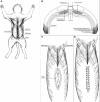Small vs. Large Suture Bite-to-Stitch Interval for Closure of Midline Celiotomy in Cats: A Biomechanical Study
- PMID: 32391388
- PMCID: PMC7188759
- DOI: 10.3389/fvets.2020.00206
Small vs. Large Suture Bite-to-Stitch Interval for Closure of Midline Celiotomy in Cats: A Biomechanical Study
Abstract
Objective: The objective of this study was to compare the bursting strength and characterize the mode of failure of cranial and caudal midline celiotomies closed with 2 suture patterns and an absorbable monofilament suture material. Design: Randomized, cadaveric, ex- vivo mechanical testing. Sample: Feline cadavers (n = 32). Methods: Specimens were randomized into two groups based on the closure technique (small 2 × 2 mm or large 5 × 5 mm suture-bite-stitch-interval [SBSI] groups). Cranial or caudal midline celiotomies, 7.5 cm long, were created. A custom-made polyurethane bladder was inserted into the abdomen, and the celiotomies were closed in a simple continuous pattern using 3-0 polydioxanone. The repair was loaded to failure by inflating the bladder with compressed air. Bursting strength and mode of failure were recorded. Effects of body weight, gender, thickness and width of linea alba, suture-bite-stitch-interval, and location of celiotomy were analyzed using a mixed model analysis and an independent t- test, with P < 0.05 considered statistically significant. Results: There was no difference in bursting strength between cranial and caudal celiotomies. Bursting strength was lower for celiotomies closed with a large SBSI (P = 0.003). Bursting strength was greater in males compared to females (P = 0.003). Twenty five specimens failed distant from celiotomy closure, while 4 failed by fascial tearing at the site of needle penetration. Failure by loosening of the suture line with intact knots only occurred in 3 caudal celiotomies closed with a large SBSI. Gender, body weight and SBSI accounted for 61.5% of variability in bursting strength (P = 0.005). Conclusions: Small SBSI technique was mechanically superior to large SBSI when tested under these loading conditions. Clinical relevance: Supraphysiological pressures were required to cause failure in all specimens. Both small and large SBSI may be clinically applicable for midline celiotomy closure in domestic cats.
Keywords: biomechanical testing; bursting strength; feline; hernia; laparotomy; suture pattern.
Copyright © 2020 Reina Rodriguez, Milgram and Kirby.
Figures




Similar articles
-
Biomechanical properties of feline ventral abdominal wall and celiotomy closure techniques.Vet Surg. 2018 Feb;47(2):193-203. doi: 10.1111/vsu.12751. Epub 2017 Nov 18. Vet Surg. 2018. PMID: 29150929 Free PMC article.
-
Ex vivo comparison of bursting strength of ventral median and right ventral paramedian celiotomies in horses.Vet Surg. 2013 May;42(4):468-72. doi: 10.1111/j.1532-950X.2013.12003.x. Epub 2013 Feb 21. Vet Surg. 2013. PMID: 23432605
-
Ex vivo comparison of 7 polydioxanone, 2 polyglactin 910 for closure of ventral median celiotomy in horses.Vet Surg. 2013 May;42(4):463-7. doi: 10.1111/j.1532-950X.2013.12002.x. Epub 2013 Feb 22. Vet Surg. 2013. PMID: 23432538
-
The Best Closure Technique Without Mesh in Elective Midline Laparotomy Closure.J Abdom Wall Surg. 2022 Dec 7;1:10962. doi: 10.3389/jaws.2022.10962. eCollection 2022. J Abdom Wall Surg. 2022. PMID: 38314158 Free PMC article. Review.
-
[Current standards of abdominal wall closure techniques : Conventional suture techniques].Chirurg. 2016 Sep;87(9):737-743. doi: 10.1007/s00104-016-0231-0. Chirurg. 2016. PMID: 27392763 Review. German.
Cited by
-
Geometrical model establishment and preoperative evaluation on A-T flap design: Finite element method-based computer-aided simulation on surgical operation processes.Front Surg. 2022 Oct 12;9:988783. doi: 10.3389/fsurg.2022.988783. eCollection 2022. Front Surg. 2022. PMID: 36311933 Free PMC article.
References
-
- De Rooster H. Celiotomy. In: Griffon D, Hamaide A, editors. Complications in Small Animal Surgery, 1st Edn. Hoboken, NJ: Wiley- Blackwell. (2016). p. 355–61. 10.1002/9781119421344.ch49 - DOI
-
- Smeak DD. Abdominal hernias. In: Bojrab MJ, editor. Disease Mechanisms in Small Animal Surgery, 2nd Edn. Philadelphia: Lippincott Williams and Wilkins; (1993). p. 98–102.
-
- Claeys S. Dehiscence. In: Griffon D, Hamaide A, editors. Complications in Small Animal Surgery, 1st Edn Hoboken, NJ: Wiley- Blackwell: (2016). p. 57–63.
-
- Crowe DT. Closure of abdominal incisions using a continuous polypropylene suture: clinical experience in 550 dogs and cats. Vet Surg. (1978) 7:74–7. 10.1111/j.1532-950X.1978.tb00584.x - DOI
LinkOut - more resources
Full Text Sources
Miscellaneous

